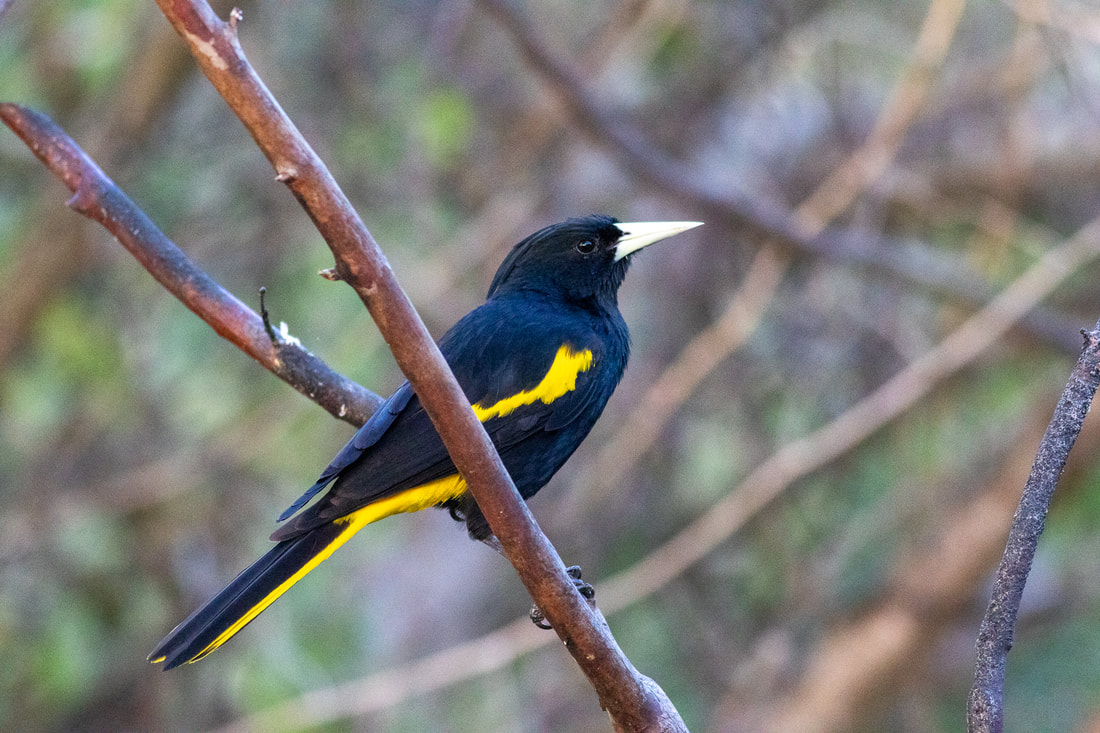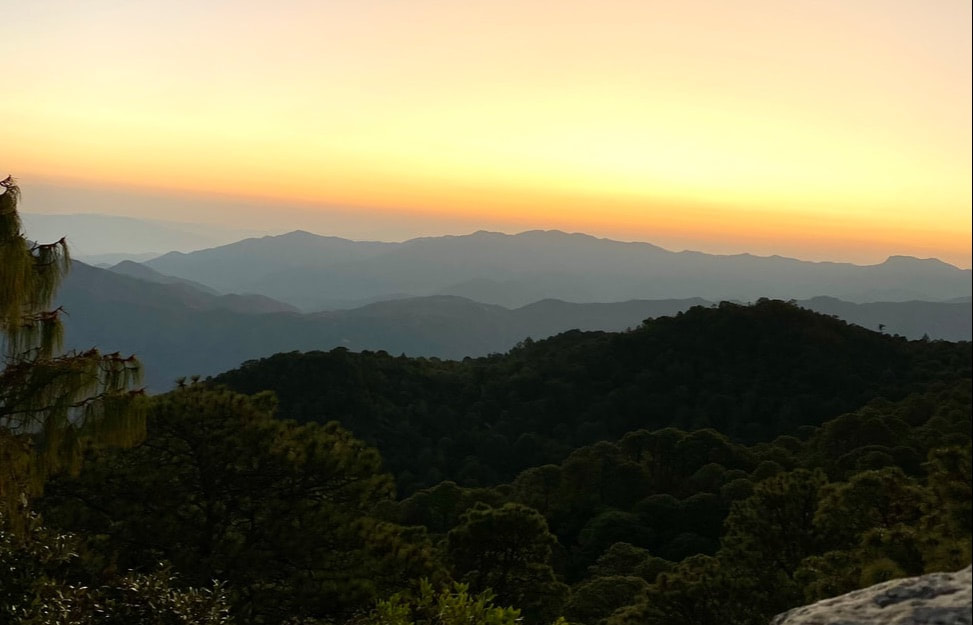36 possible endemic species...Endemism is highly prevalent in West Mexico. We have the chance to see up to 36 species of endemics on this tour!! From the adorable and tiny Bumblebee Hummingbird to the gregarious Tufted Jay. You will undoubtedly see some lifers if this is your first visit to this area!
|
From the coast to the mountains...We will see a wide range of environments on our tour, including mangroves, high elevation pine forests, volcanic islands in the Pacific, and sandy beaches along the coast. We will get the opportunity to carefully study the distinct birds and ecosystems found in each location.
|
Tour Information
Dates: March 10-19, 2025
These dates have been selected for the best birding in western Mexico. In March, there are still plenty of migrant species from the United States and Canada in the area as well as all of the resident Mexican species. This tour offers a perfect late winter getaway for anyone wishing to escape the cold!
Tour Leaders:
Dates: March 10-19, 2025
These dates have been selected for the best birding in western Mexico. In March, there are still plenty of migrant species from the United States and Canada in the area as well as all of the resident Mexican species. This tour offers a perfect late winter getaway for anyone wishing to escape the cold!
Tour Leaders:
Cost: $4855 CAD | $3600 USD |£3140 GBP
The tour fee above its based on double occupancy and includes all ground transportation, accommodation, all meals and professional guiding services. Single Supplement available for $1100 CAD.
Deposit and Cancellation Information: $700 CAD | $550 USD
The deposit for this tour becomes non-refundable 200 days prior to the starting date of the tour. The remaining balance is due by November 1, 2024.
Group Size: 4-10 participants
This small group size and high guide to participant ratio ensures that everyone will have an enjoyable experience on this tour.
The tour fee above its based on double occupancy and includes all ground transportation, accommodation, all meals and professional guiding services. Single Supplement available for $1100 CAD.
Deposit and Cancellation Information: $700 CAD | $550 USD
The deposit for this tour becomes non-refundable 200 days prior to the starting date of the tour. The remaining balance is due by November 1, 2024.
Group Size: 4-10 participants
This small group size and high guide to participant ratio ensures that everyone will have an enjoyable experience on this tour.
Itinerary
March 10: Arrive in Puerto Vallarta
We will arrive in Puerto Vallarta (PVR) today and settle into our beachside hotel which will be our base for three nights . If time allows we will spend some time birding at a nearby golf course before dinner. We will spend the first morning of the tour birding near the
March 11: Boca de Tomate and Puerto Vallarta
The first morning of the tour will be spent birding close at the mouth of the Ameca River , which empties into the Pacific Ocean. Along with being a vital habitat for birds, the river separates the Mexican states of Jalisco and Nayarit. We'll search the sandy shores for species such as Whimbrel, Wilson's Plover, and Western Sandpiper. We can expect to see a variety of waders, such as Little Blue Heron, Tricolored Heron, and Snowy Egret, in addition to shorebirds. Magnificent Frigatebirds and Brown Pelicans should also be visible to us as they cruise offshore. We will search for species like Citreoline Trogon in the trees that encircle the shore, in addition to endemics like the Golden-cheeked Woodpecker and San Blas Jay.
March 12: Rancho Primavera
Today we will to drive to Rancho Primavera, a former ranch turned bird sanctuary, which is located south of Puerto Vallarta. We'll be birding on the ranch and in the vicinity of El Tuito, a small town, for the majority of the day. We will begin by going to a few active feeders that are frequently visited by hummingbirds, including Cinnamon Hummingbird, Berylline Hummingbird, Plain-capped Starthroat, and Broad-billed Hummingbird. Yellow-winged Cacique, Streak-backed Oriole, Yellow Grosbeak, Cinnamon-bellied Saltator, and the secretive endemic Blue Mockingbird are among the regular non-hummingbird visitors. We will explore the few small ponds on the property, which are frequently inhabited by Least Grebes and Black-bellied Whistling Ducks. The largest kingfisher in North America, the Ringed Kingfisher, often patrols these ponds. We will also be on the lookout the spectacular Military Macaw and the endangered Lilac-crowned Parrot.
March 13: Mismaloya to San Sebastian
This morning we will head south of Puerto Vallarta again to bird the surroundings of a small town called Mismaloya. We hope to encounter species such as West Mexican Chachalaca and both Colima and Ferruginous Pygmy-Owls. Other potential species include Russet-crowned Motmot, Elegant Trogon, and Lineated Woodpecker. After a refreshing lunch along the ocean we will drive to the small town of San Sebastian where we will base ourselves for one night.
March 14: Cerro La Bufa to San Blas
Today we drive up to the summit of La Bufa for sunrise. From the peak, we will take in the incredible view extending all the way to the Pacific Ocean. We will also be on the lookout for many specialty, high-elevation species including the endemic Rufous-capped Brushfinch, as well as Tufted Flycatcher and Olive Warbler. As we slowly bird our way down the mountain, we hope to encounter Transvolcanic Jay, Elegant Euphonia, Chestnut Shrike-Vireo, Red-faced Warbler and possibly Red Warbler. Other endemics we hope to see today included Red-headed Tanager, Spotted Wren, Black-headed Siskin and the tiny Bumblebee Hummingbird. In the afternoon we will begin our journey to the coastal town of San Blas, where we will spend the next three nights. We will make sure there is time to allow a couple of stops along the way, including a roadside stop for Orange-breasted Bunting.
March 15: Mangrove Boat Tour and lowlands near San Blas
We will start the day by taking a leisurely boat ride through the mangrove swamp system, this is sure to be one of the highlights of the tour. We hope to see many species this morning including our first Rufous-necked Wood Rails and Bare-throated Tiger-Herons of the tour. If we are lucky, we may spot a roosting Boat-billed Heron or Northern Potoo as we cruise through the mangroves. Once we reach our destination, Laguna de Zoquipan we will begin to search for more difficult species like Spotted Rail, Snail Kite and the localized Yellow-breasted Crake. After lunch, we will bird the surrounding lowlands hoping to encounter new species for the tour such as Mangrove Vireo, Mangrove Swallow as well as familiar species such as Yellow-winged Cacique, Citreoline Trogon and Golden-cheeked Woodpecker.
March 16: Isla Isabel
We will spend the entirety of this day on the water and on Isla Isabel. We will depart from San Blas early in the morning to travel approximately 70km north to Isla Isabel. On the journey we will keep our eyes open for seabirds such as Black-vented Shearwater and Least Storm-Petrel. Isla Isabel is a protected island that is a vital nesting colony for thousands of Magnificent Frigatebirds, Blue-footed Boobies, Brown Boobies and small numbers of Brown Noddies and Red-footed Boobies.
March 17: Highlands near San Blas to Mazatlan
Today we will once again climb to higher elevations in the nearby foothills overlooking the lowlands of San Blas. Here we hope to see species like, Black-throated Magpie-Jay, Orange-fronted Parakeets, and possibly Red-breasted Chat and the endemic Flammulated Flycatcher. Later in the day we will drive to Mazatlan, our final destination of the tour. Depending on time, we will spend some time birding along the beach before sunset.
March 18: Reserva de la Chara Pinta
Today will be spent at Reserva de la Chara Pinta. It is at this location that we will attempt to find one of the most sought after birds west Mexico has to offer, the charismatic Tufted Jay. We will also enjoy some truly fantastic birding at this location,with chances to see both Red and Red-faced Warbler, and the near endemic Eared Quetzal. We alos have the opportunity to see some species that we may have encountered earlier such as, Blue-throated Mountain-gem, Mountain Trogon, Pine Flycatcher, Rusty-crowned Ground-Sparrow, and Golden-browed Warbler. If we are lucky we may also find Stygian Owl, one of the most enigmatic owls in the world.
March 19: Coastal birding near Mazatlan & Departure
On our final day in Mexico we will spend the morning birding along the coast of Mazatlan. Species we hope to find include, Black-throated Magpie-Jay, Elegant Quail, Cinnamon Hummingbird, Sinaloa Crow. We will conclude the tour in the late morning before lunch.
We will arrive in Puerto Vallarta (PVR) today and settle into our beachside hotel which will be our base for three nights . If time allows we will spend some time birding at a nearby golf course before dinner. We will spend the first morning of the tour birding near the
March 11: Boca de Tomate and Puerto Vallarta
The first morning of the tour will be spent birding close at the mouth of the Ameca River , which empties into the Pacific Ocean. Along with being a vital habitat for birds, the river separates the Mexican states of Jalisco and Nayarit. We'll search the sandy shores for species such as Whimbrel, Wilson's Plover, and Western Sandpiper. We can expect to see a variety of waders, such as Little Blue Heron, Tricolored Heron, and Snowy Egret, in addition to shorebirds. Magnificent Frigatebirds and Brown Pelicans should also be visible to us as they cruise offshore. We will search for species like Citreoline Trogon in the trees that encircle the shore, in addition to endemics like the Golden-cheeked Woodpecker and San Blas Jay.
March 12: Rancho Primavera
Today we will to drive to Rancho Primavera, a former ranch turned bird sanctuary, which is located south of Puerto Vallarta. We'll be birding on the ranch and in the vicinity of El Tuito, a small town, for the majority of the day. We will begin by going to a few active feeders that are frequently visited by hummingbirds, including Cinnamon Hummingbird, Berylline Hummingbird, Plain-capped Starthroat, and Broad-billed Hummingbird. Yellow-winged Cacique, Streak-backed Oriole, Yellow Grosbeak, Cinnamon-bellied Saltator, and the secretive endemic Blue Mockingbird are among the regular non-hummingbird visitors. We will explore the few small ponds on the property, which are frequently inhabited by Least Grebes and Black-bellied Whistling Ducks. The largest kingfisher in North America, the Ringed Kingfisher, often patrols these ponds. We will also be on the lookout the spectacular Military Macaw and the endangered Lilac-crowned Parrot.
March 13: Mismaloya to San Sebastian
This morning we will head south of Puerto Vallarta again to bird the surroundings of a small town called Mismaloya. We hope to encounter species such as West Mexican Chachalaca and both Colima and Ferruginous Pygmy-Owls. Other potential species include Russet-crowned Motmot, Elegant Trogon, and Lineated Woodpecker. After a refreshing lunch along the ocean we will drive to the small town of San Sebastian where we will base ourselves for one night.
March 14: Cerro La Bufa to San Blas
Today we drive up to the summit of La Bufa for sunrise. From the peak, we will take in the incredible view extending all the way to the Pacific Ocean. We will also be on the lookout for many specialty, high-elevation species including the endemic Rufous-capped Brushfinch, as well as Tufted Flycatcher and Olive Warbler. As we slowly bird our way down the mountain, we hope to encounter Transvolcanic Jay, Elegant Euphonia, Chestnut Shrike-Vireo, Red-faced Warbler and possibly Red Warbler. Other endemics we hope to see today included Red-headed Tanager, Spotted Wren, Black-headed Siskin and the tiny Bumblebee Hummingbird. In the afternoon we will begin our journey to the coastal town of San Blas, where we will spend the next three nights. We will make sure there is time to allow a couple of stops along the way, including a roadside stop for Orange-breasted Bunting.
March 15: Mangrove Boat Tour and lowlands near San Blas
We will start the day by taking a leisurely boat ride through the mangrove swamp system, this is sure to be one of the highlights of the tour. We hope to see many species this morning including our first Rufous-necked Wood Rails and Bare-throated Tiger-Herons of the tour. If we are lucky, we may spot a roosting Boat-billed Heron or Northern Potoo as we cruise through the mangroves. Once we reach our destination, Laguna de Zoquipan we will begin to search for more difficult species like Spotted Rail, Snail Kite and the localized Yellow-breasted Crake. After lunch, we will bird the surrounding lowlands hoping to encounter new species for the tour such as Mangrove Vireo, Mangrove Swallow as well as familiar species such as Yellow-winged Cacique, Citreoline Trogon and Golden-cheeked Woodpecker.
March 16: Isla Isabel
We will spend the entirety of this day on the water and on Isla Isabel. We will depart from San Blas early in the morning to travel approximately 70km north to Isla Isabel. On the journey we will keep our eyes open for seabirds such as Black-vented Shearwater and Least Storm-Petrel. Isla Isabel is a protected island that is a vital nesting colony for thousands of Magnificent Frigatebirds, Blue-footed Boobies, Brown Boobies and small numbers of Brown Noddies and Red-footed Boobies.
March 17: Highlands near San Blas to Mazatlan
Today we will once again climb to higher elevations in the nearby foothills overlooking the lowlands of San Blas. Here we hope to see species like, Black-throated Magpie-Jay, Orange-fronted Parakeets, and possibly Red-breasted Chat and the endemic Flammulated Flycatcher. Later in the day we will drive to Mazatlan, our final destination of the tour. Depending on time, we will spend some time birding along the beach before sunset.
March 18: Reserva de la Chara Pinta
Today will be spent at Reserva de la Chara Pinta. It is at this location that we will attempt to find one of the most sought after birds west Mexico has to offer, the charismatic Tufted Jay. We will also enjoy some truly fantastic birding at this location,with chances to see both Red and Red-faced Warbler, and the near endemic Eared Quetzal. We alos have the opportunity to see some species that we may have encountered earlier such as, Blue-throated Mountain-gem, Mountain Trogon, Pine Flycatcher, Rusty-crowned Ground-Sparrow, and Golden-browed Warbler. If we are lucky we may also find Stygian Owl, one of the most enigmatic owls in the world.
March 19: Coastal birding near Mazatlan & Departure
On our final day in Mexico we will spend the morning birding along the coast of Mazatlan. Species we hope to find include, Black-throated Magpie-Jay, Elegant Quail, Cinnamon Hummingbird, Sinaloa Crow. We will conclude the tour in the late morning before lunch.




